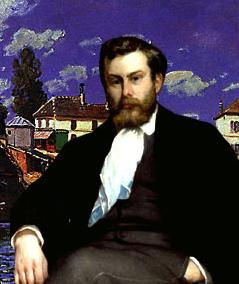(Paris 1839- Moret-sur-Loing 1899)
A student of the School of Fine Arts in Paris, in Gleyre's workshop, where he befriended Renoir and Monet; the latter, along with Corot, had a great influence on his work. In 1863, Sisley left this workshop and began to work in the Paris region, in Chailly-en-Bière, and painted numerous landscapes of the Fontainebleau forest, reminiscent of those by the Barbizon painters. The works from this period are scarce, as he practiced painting purely as a hobby, since his family largely covered his needs (The Tavern of Comadre Anthony, 1866; The Avenue of the Chestnuts, Museum of Fine Arts in Paris).
In 1870, fleeing the Prussian invasion, which ruined his family, he took refuge in London with Monet and Pissarro. During this period, he befriended Durand-Ruel, who bought some of his canvases. Back in France, attracted by the light of the Paris region, which he tried to reproduce in its various time phases, he painted landscapes of the Seine, Loing, Bougival, Voisins, Marly, Meudon, Saint-Cloud… From 1875 to 1879, he resided in Sèvres; later he moved to Moret, where he lived the last twenty years of his life.
The Louvre Museum possesses a good number of landscapes that allow for judging his evolution, such as: The Boat During the Flood (1873), The Regattas (1874). In 1874, the first exhibition of the Impressionists took place, and Sisley participated, along with Monet, Pissarro, Degas, Renoir… in the founding of the Anonymous Society of Painters, Sculptors, and Engravers.
In 1879, he attended the official Salon in the hope of escaping poverty, but did not achieve the expected success; in 1884, three of his canvases were offered to the government by Caillebotte and were rejected. This series of failures led the artist to remain isolated in Moret, limiting himself to regularly sending his works to the Salon of the National Society of Fine Arts. Subsequently, interest in his work grew, which achieved extraordinary success.
A student of the School of Fine Arts in Paris, in Gleyre's workshop, where he befriended Renoir and Monet; the latter, along with Corot, had a great influence on his work. In 1863, Sisley left this workshop and began to work in the Paris region, in Chailly-en-Bière, and painted numerous landscapes of the Fontainebleau forest, reminiscent of those by the Barbizon painters. The works from this period are scarce, as he practiced painting purely as a hobby, since his family largely covered his needs (The Tavern of Comadre Anthony, 1866; The Avenue of the Chestnuts, Museum of Fine Arts in Paris).
In 1870, fleeing the Prussian invasion, which ruined his family, he took refuge in London with Monet and Pissarro. During this period, he befriended Durand-Ruel, who bought some of his canvases. Back in France, attracted by the light of the Paris region, which he tried to reproduce in its various time phases, he painted landscapes of the Seine, Loing, Bougival, Voisins, Marly, Meudon, Saint-Cloud… From 1875 to 1879, he resided in Sèvres; later he moved to Moret, where he lived the last twenty years of his life.
The Louvre Museum possesses a good number of landscapes that allow for judging his evolution, such as: The Boat During the Flood (1873), The Regattas (1874). In 1874, the first exhibition of the Impressionists took place, and Sisley participated, along with Monet, Pissarro, Degas, Renoir… in the founding of the Anonymous Society of Painters, Sculptors, and Engravers.
In 1879, he attended the official Salon in the hope of escaping poverty, but did not achieve the expected success; in 1884, three of his canvases were offered to the government by Caillebotte and were rejected. This series of failures led the artist to remain isolated in Moret, limiting himself to regularly sending his works to the Salon of the National Society of Fine Arts. Subsequently, interest in his work grew, which achieved extraordinary success.

 World Art Day: 10% in original artworks
World Art Day: 10% in original artworks 
